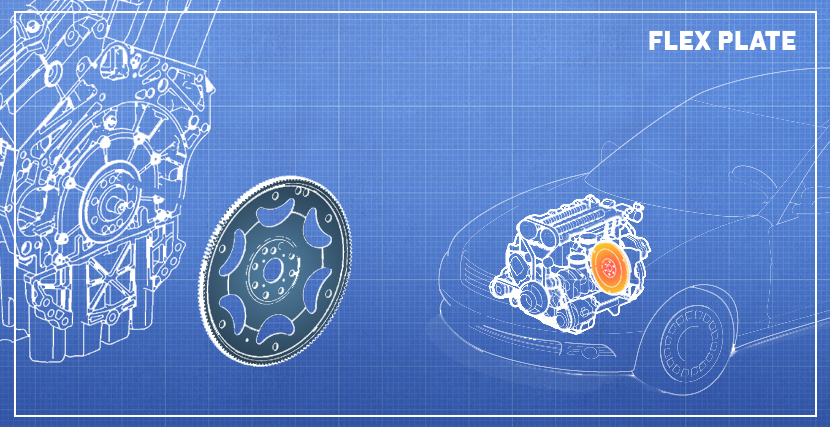Flex Plate
A flex plate is a counterpart of a flywheel found in vehicles with a manual transmission. A flex plate takes its place in trucks and cars with an automatic transmission. Along with an engine, transmission and other related parts, it is a key component of the vehicle’s powertrain which is actually what causes your vehicle to move, and is responsible for its proper acceleration, braking and cruising.

By design, your flex plate is a metal disc that connects the crankshaft to the torque converter, so it can transfer engine power to the wheels. It also features a ring gear around the plate to mate with the starter’s gear when you turn on the ignition key to start the engine. Thanks to its light weight and thickness your flex plate absorbs some misalignment between the engine and the transmission system as well as irregularities in engine operation. In tandem with the torque converter, the flex plate allows for smooth transferring of power to the transmission.
In vehicles with an automatic transmission, a flex plate performs the function of a flywheel in cars and trucks with three pedals near your feet. However, a flywheel and a flex plate are not the same, so they are not interchangeable.
Signs of a bad flex plate
A flex plate is a crucial part of your powertrain, delivering engine power to the transmission, so its failure to operate properly will result in inability to control the vehicle’s power. Since the power is not transferred to the wheels, you may lose control over your car or truck, which may result in an accident. To avoid such a bad experience, let’s check out the most common warning signs of a failed flex plate.
- Abnormal noises (grinding, clunking, chirping or rattling) from the flex plate area when idling
- Knocking when you shift the vehicle into drive or reverse
- Excessive vibration at normal speeds
- Your engine runs rough
- Lack of power at higher speeds
- Increased fuel consumption
- Whining noise from the starter
- Your starter can’t crank the engine
Problems with your flex plate can be a sign of the malfunctioning transmission, so it’s always a good idea to inspect them together.
Flex plate repair
Unfortunately, a worn-out or damaged flex plate is not repairable, so the only way to fix the problem is to replace it. Being an integral part of your powertrain, replacing a flex plate involves removing the transmission and, therefore, a lot of labor.
Before replacing the flex plate, your mechanic will remove the cover shielding it to check the condition of the flex plate and whether it needs a replacement. If so, he or she will take off the transmission and then replace the flex plate with another one. The final step is reassembling the transmission, checking it for any signs of damage or premature wear, and its proper aligning.
Can I replace a bad flex plate myself?
Unless you’re a qualified mechanic with many years of experience working on automatic transmissions, it’s better to hire a professional. Both your flex plate and transmission must be precisely aligned as well as every bolt that holds them is torqued down properly and in the correct order.
Failure to install the flex plate properly will force you to repeat the process again with the potential risk of getting damage to your transmission.